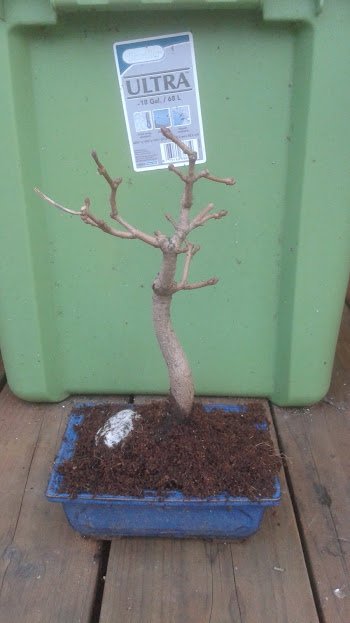
This little stick in a pot is a maple tree I have been slowly developing to become a bonsai tree.
This post will be part of my series of posts on cleaning up my bonsai trees with winter pruning. Most of the prunes I make are removing dead wood, and also applying the Rule of Two, which I'll be demonstrating in this post.
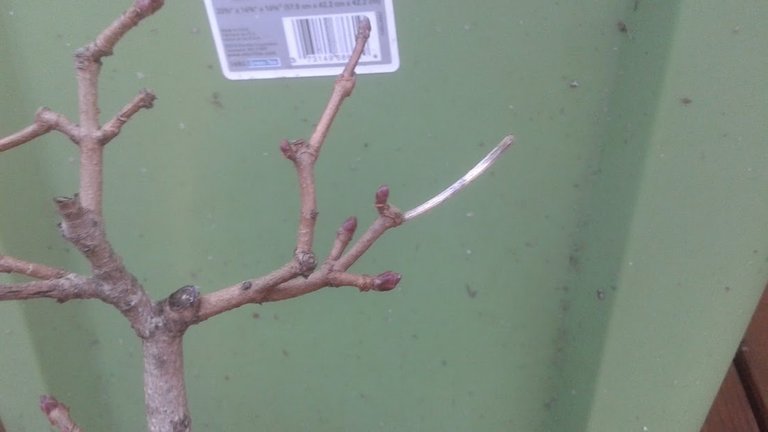
Taking a closer look, I turned the tree around to show a close up of the longest side branch.
Strategy:
- Remove dead branches and dead stubs where old cut marks are.
- Cut back dead wood until the cut line is smooth against the living branch.
- Remove the middle branch at the end, so it divides into two branches instead of three.
- Remove the upward heading branch.
The main branch I am removing because it is going to shade out the lower branch, and probably also prevent the buds on the lower branch from developing. Some bonsai growers like to have branches grow under difficult conditions like this, because it starves the branches and keeps them smaller. I prefer to keep all parts of the tree strong, so it gets lots of sunlight on all the buds.
The upward branch is also competing with the apex of the tree for dominance, so that also re-affirms my choice. Selective pruning is art and science.
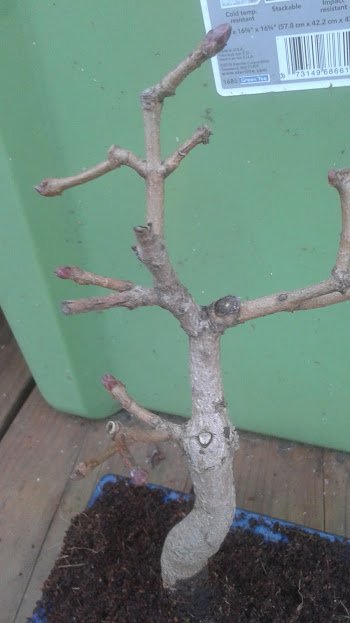
Here I'm looking at the branches on the other side of the trunk, including the trunk itself.
Same Strategy:
- Remove the dead wood areas. Lots of old stumps to smooth out.
- At the top where the branch divides into three, remove the lower right branch.
The branch I am removing already looks weak and possibly dead. I is heading in the same direction as the branch above it, and it is getting shaded out by it. That is why it makes sense to remove the weak lower right branch.

This upper view shows most of the branch directions best.
In the next photo I'll be showing the same view, except I used photoshop to paint out marks to help show the design choices I made for all the pruning. All the cut marks in magenta, the silhouette of the tree in black, the buds in yellow, and the expected direction of the future branches in green.
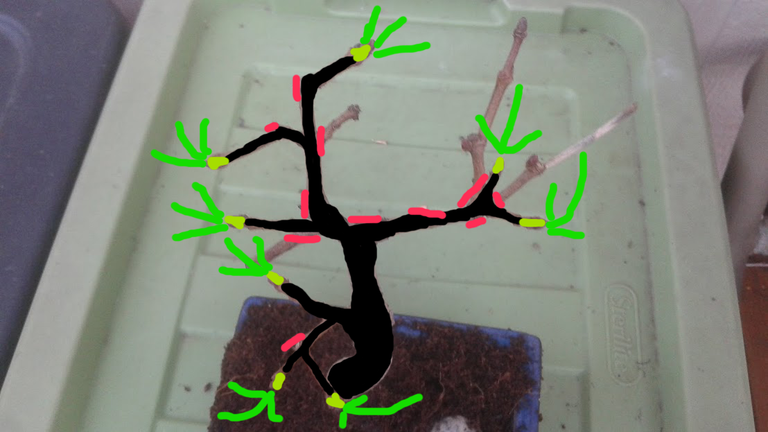
I only removed about three budding branches. That still leaves the possibility of up to 16 new branch division to form, from the remaining buds.
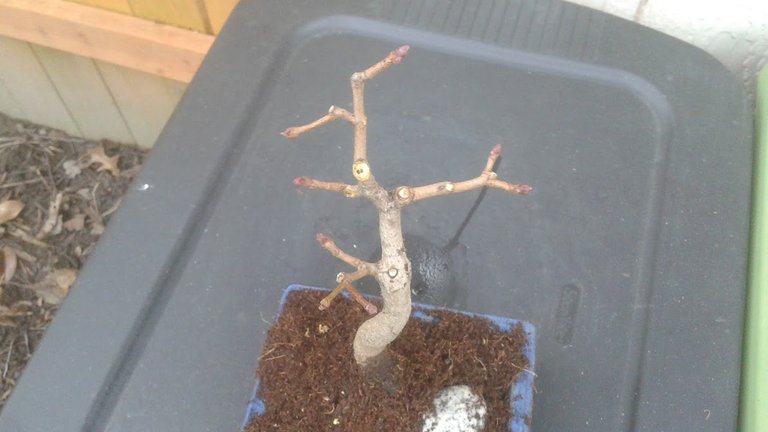
Here is the end result.
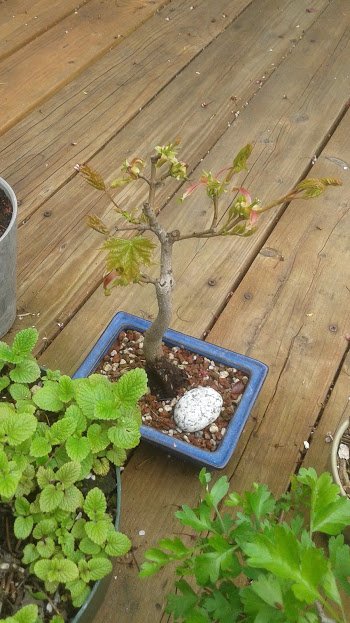
Last year, this is what it looked liked like once the leaves started forming.
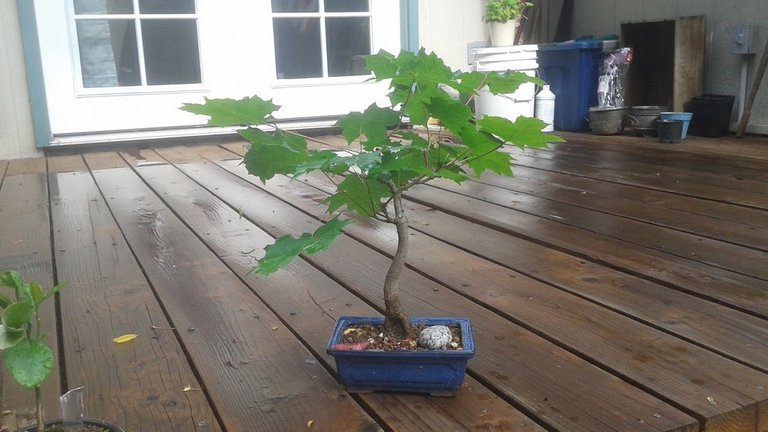
Last year, this is what the tree looked like with the leaves fully grown.
All I had originally was a single stem with a three short branches with buds on them.
In one year it has come a long, long way. Patience has its small rewards in nature.
Thank you so much for viewing my post. If you can't stand watching me butcher these tiny trees (to the best of my current abilities), then you might not want to follow me this week. From time to time, I also share posts about my garden. Currently I am nurturing vegetable and flowers indoors that I grew from seeds. Sometimes I write about life experiences that have enriched me. Other times I just put up something silly because it makes me laugh and I want to share it with others who need a chuckle.
Have a great day!
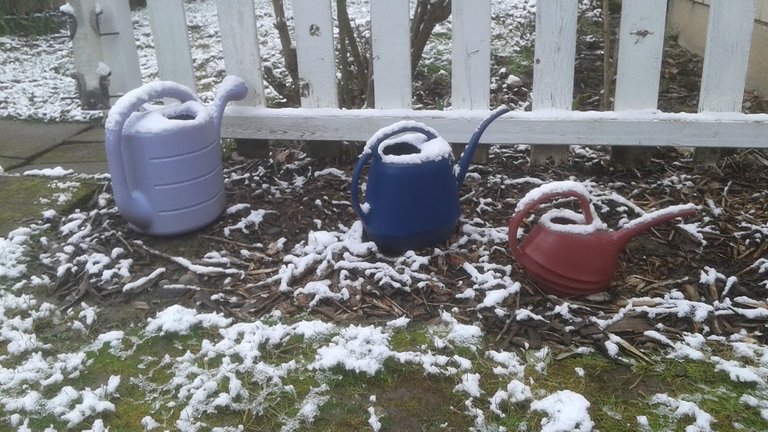

hello friend @creativetruth I really like your publications, and you have an excellent technology to work your trees, congratulations, I am aware of your publication I have a lot of information, in my house we try to create vegetable gardens, of daily use in the kitchen, more than all legumes.
Thank you. I am really impressed when people from other countries are reaching out to me to say nice things. Learning English is very challenging. What are your favorite vegetables to grow and eat? I love growing corn and carrots, but peas are my favorite to snack on.
if it is exciting how we can communicate, I am very excited to see that we can communicate regardless of the distance, at home I have, parsley, fresh mint, chives that are from the family of onions and a small paprika I really like having those plants at home, I know I can get them at the grocery store but having them at home gives me a sense of freshness, I do not have much space to have them, but I try to keep them safe. I love corn and carrots, but I do not have much space to grow them.I work in a school, and there are gardens made by the students that it is beautiful to admire the team work, I am about to upload an article about them.@creativetruth
Hey there! I forgot to mention you in the mega update, I have a trick I learned that maybe could help you when the weather gets sunnier, or you could even try it at winter and see how it goes. I learned that vaseline can help a lot to everything over the soil, that meaning the branches, leaves and the trunk, stems (don't know which is the proper term).. I use it for avocado trees, because the soil here tends to dry very soon, even when I mulch it down the heat is too high over here, and the soil really dry and clay-like. So I use two tricks for them, I apply the vaseline to the whole plant with a small-medium brush, that makes the leaves very brilliant and resistant (I only paint the front part facing up and outside, not the whole leave, and depending on their size ou could only put vaseline to the branches that look dry, if you do it you'll know right away what it does!). And the second one is that I grow big trees in medium-large pots, because that helps the soil to keep its humidity and I can move them around, depending on the sunlight position. I even found that when I put the larger or bigger ones below a roof the leaves got bigger than in the sun (filtered sunlight or merely radiation, never direct sun)! I will try to keep up documenting what I have and hopefully you can see what I'm talking about! The vaseline trick may also help to give a more efficient protection after pruning and specially on the spots where you want to grow new stems!
I hope you understood at least half of what I just wrote lol. Cheers and thank you for posting this!! Oh! and I forgot, I'm assuming that being winter and all you try to not put as much hand on the bonsais as in a warmer weather. But I wanted to ask, is there a season when you prune the roots as well? I think that's the only thing I learned before about bonsai, that the best trick was in the root pruning. I'm learning a little bit of that with my experiments, but the only thing I do bonsai related are the bigger trees into a big pot (It isn't that big, more like a medium size, maybe 2 1/2 ft tall and the same in diameter). With a desert rose (Adenium obesum) what I do is to try to elevate the roots of the plant above the soil (hard to explain I know), using a stick or piece of wood and a piece of cloth to protect, I keep steady the trunk by ataching it to the wood (or metal bar, anything that serves as a column or base to the tree, a tutor is called here, to train a tree) and that way I can move up the entire plant, so its roots end up outside the soil but touching it with every root end(instead of really burying them, the are on top but with a part buried, not all of it). That really helps the plant to reach a more mature stage, and the roots can quickly (or quickier) become baobab (bonsai) alike, because they now have the entire soil to spread more roots. The other thing to do would be to move the plant to a bigger pot but instead of filling the entire pot with soil, I only fill like a 1/4 or a third at maximum and I plant the tree (bonsai) in the bottom, without burying in soil, always trying to leave the roots as outside as I can, that way they breath better and mature even more fast than covered whole in soil! That makes the plant to grow a lot more and it has better protection because of the rest of the pot serving as a wall. That's also a good idea for a post. My goal isn't to keep them bonsai but the entire opposite I think: I introduce very small plants to a larger pot and by planting it in the very bottom, it kind of evolves or grows three to ten times as bigger as the original or normal size would, the results are so different that I normally make plants as little as a peppermit big as a tomato, but the one that really surprised me was the Desert rose! I'll post that one too very soon.
I have never written this in english (in spanish neither, they are things I've been learning and practicing for years) so I will leave a link for youtube where I think you may understand a little better what I just ripped apart in the form of text lol. Again, thank you for sharing all of your thoughts, updates and posts. To me it looks like a great adventure. Have a great week!
Sorry I couldn't find enlgish vids, and these aren't even about what I told you lol, but you can see a part of which I did try to explain! Cheers!
What a whopper! You definitely presented a lot of different techniques. That tubular strategy is not one I have seen before. I'm not much of a fan of the long fat trees. They kind of remind me of a carrot.
Never heard of using Vaseline either. I'm guessing this is something people in the desert/tropical regions are more familiar with. I might try this out on my lemon tree, a tropical with tough glossy leaves, and see how I like it.
In my climate, it is harder to get the water to percolate out of the pot, so we tend to focus on soil that drains very well.
I usually focus on slow growth and smaller pots, because I am limited on space and how much I can spend on pots and tools. I am in no hurry. Some of the tree varieties I am growing will take me many more years to learn the needs of that species and how it grows. Timing of work on one tree is not good on other trees.
Most of my trees can be root pruned in early spring. I try to focus on pruning the roots into a radial pattern from the trunk, and removing anything that looks like it will criss-cross and strangle other roots. If I get a long root coiling around the pot, I cut it so it only reaches from the trunk to the edge of the pot. Sometimes I also remove thick roots buried deep under the soil the tree grew from years ago, but no longer needs.
Yeah, we probably live in two exact weather opposites!. Even though you won't be having a bonsai of a carrot, maybe it can help you to think of stronger roots or at least how to help them in case of an emergency or special care for one of your babies. I have the same problems with the draining, but not for the same reason. What I learned in another steemit post was that my soil, being too much clayish absorbs way too much heat, and that results in my soil becoming a hard brick of dirt, and that really damages my plants and their roots. It's also very difficult for me to find good products to add to my soil, like coco coir or perlite I think is its name. One of my goals now is to make my own vermicompost, and to crush several dry coconuts which I can find but the hardest part is to find someone else's machine to shred them for me. I always end up doing it with a butcher's knife lol. But the truly amazing part about my learning was to find that even though the weather around here is so heavy because of the heat, I could find an improvement in my gardens and now I can aim at bigger goals, like growing lots of food and without having the winter to make me speed my times like you said. I'm always aware of that, and the only reason why my plants are growing that fast is because of the sun being to close to this geographic zone all year long. I have to move as much plants as I can at least three times a year, to find shade and to translate the sun radiation into actual growth in the plants and their cycles, if I don't many plants die in just a lunch break at noon, I've had several losses in just one morning of venezuelan sun. It's also very challenging for me to be able to see many of your plants which I "couldn't" grow here, many people for years before this telling me that I wouldn't grow anything because of the weather. So, I'm not only excelling at that, but also I'm happy for being the first person here in a long time who can be a pioneer in growing flowers and food that currently can only be imported or brought from very far towns! I know I'm learning a lot, and posts like these only make want to be better and to try to know people like you, maybe we don't share the same road, but the community and its future looks very promising! Thank you a lot for taking the time to check this out! The goal is to have fun and I'm very happy to do what so many don't want to! Now I know I'm crazy but never alone lol ! Thanks and good luck in winter! How much is it going to last?
We probably have another month and a half of frost to be careful of.
Can I make a suggestion? You probably already know, but you can try growing plants with some tall palm-like leaves to help give some dappled shade. Put them into pots, and move them to wherever you in-ground vegetables are growing. That way your vegetables don't get scorched, or have to be moved. I always liked plants like Yucca for their snaking trunks and long spiky leaves. There are many hardy palm varieties that probably grow easy in your area. I sort of do this same strategy by using my big leafy bonsai trees to help shade some of the flowers I grow that don't like direct sun all day.
Making your own coir sounds like a lot of work? Do they have any aquaponic or animal feed stores in your area? Or even a home depot or Lowe's? I can usually buy a block of coir for $10 USD, but sometimes stores run out or don't carry it, so I sometimes ask if they will order it for me. I do not use coco fiber for my older bonsai trees inside the soil, only as a winter top mulch.
In your case, maybe adding a wet mulch like that would help cool down the clay inside the soil. Small pine bark could give you the same effect, and look better for bonsai, but they probably don't have pine trees as a resource in your area.
We try to only use akadama clay, from a volcano, because it has a unique porous quality that channels roots into smaller and smaller divisions, rather than the plate-like clay that is more cheaply available. The theory, as I understand, when combined with lava rock, there are pockets holes for the water, air, roots, and clay to hide from the sun's light and heat.
Having the clay cake together and then baking in the sun sounds like a bad recipe for cooked tree roots. I try to use the best soil mix possible for my trees, but it sounds like that is harder to acquire in your area. I would probably move my trees to a covered shaded area if I noticed leaves and soil drying after watering a few hours ago. Cooked steamed roots can kill a tree just as much as baking clay. Maybe use taller trees to provide some umbrella shade, like I suggested for your veggies. It will bring the temperature down to form a new micro-climate zone in your yard.
Exactly! I was not only thinking about that a couple weeks ago, to use taller plants as a roof or at least take some of the direct sun from the medium and little ones, but the idea of turning an arid zone into a new microclimate is what I was trying to explain as my new acquired talent over here. Even to move them around in pots is something I was planning not too long ago. The main problem is that of resources. Like I said, there are ways to find nice palm trees or the coco coir already treated to prevent bad fungus, but they aren't anywhere near, and aren't any cheap either. There are food growers but most of them only plant papaya (nice one for taking light and heat), watermelons, cantaloupes, and squash too. In some areas you can find plantain and bananas, but it's not that common now because of problems with the water supply. Most people would suggest not to grow anything in the entire peninsula I live in, cause even being surrounded by sea, the companies around aren't capable to have a nice water supply system for the population, (don't get me started with the government lol) but the fact is that what I'm doing here you can count with your hand the other ones doing the same thing. For me to buy a decent size palm tree it would mean to spend almost an entire month of my income. That's why I decided to grow them in the first place, to be able to sell them to hotels, malls and even larger areas. I had a couple of them but like I said, even those that you would say can take the direct sunlight really cannot. The sunlight here can kill anything without a proper watering. How did I solve that?? Easy, I used greenhouse theory to always try to manage humidity in the area, because it isn't just the shade that you need, it's also to transform the soil and that everything can be put together without interrupting the micro-system needs, that means temperature and soil as well. I'm currently using different combinations of plants to turn the soil into a more healthy and less clay to bake, using also grass to maintain the humidity, because mulching isn't enough. One more thing that I considered as I thought about moving the taller trees around in pots was what I call the "sunlight's redirection or redistribution", it means that if I have let's say 50 plants in a zone and I still feel like there's more light or heat than they can handle, I put more resistant plants into the area so they help not only with their shadow, but abosrbing and transforming the heat into cooler winds. My main experiment consists in how trees have that ability to cool down an area. It's not just about shadow, they serve as a water plant that builds oxygen into the air, making it cooler as the water moves around and even within the plant itself (Most oxygen is vapor made by the heat to the soil, not within the plant). Many can turn any pollution into cool and less contaminated air to breathe, and if they create that of a cycle, that means that the winds are kind of regulated by the humidity that the sun and the trees make happen. So I learned not to use only the "roof technique" but to involve also air, water and earth, including rocks and even animals, of course, to the micro-climate. Every ecosystem interacts and manages the weather more than we think. We also have the power to do so. And that is what I'm trying to accomplish not only in my region, but in a more promising scenario, in which I can put all of my work into new projects. My yard can do fine, but the entire town and country is falling apart, and this is because most of the population still don't understand that we need to be involved in our development as communities, as people in order to survive any crisis. It's very hard to try to help others when you hardly can do so little, and that is what you can hear most people here say. But I'm not going to be one of those. I'm sure that I can set a great example, and we are proof of that! I'm aware of the many accomplishments that working with the environment has, and I'm confident that there is a way to restore this climate at least to a point in which one can look at a healthy land instead of a desertic abandoned town!
Hi @creativetruth, good publication, I love the maples but the climate of my city is a little hot and they die, tell me about the substrate, I see that you use a thick material and then you put something on it that makes the effect of mulch, but what material is it?
Most people here either bury their trees, put them in a greenhouse, or layer with inches of thick mulch, such as bark dust, and put against a building to protect. I use coconut/coir fiber. I like it because it is clean and easy to sculpt around the pots like clay when moistened. In winter we don't want to water the dormant trees as much, and we have to protect the roots from the heavy rain and ice build-up. The mulch wicks up water from both the inside and outside, so the tree won't ever sit in a water puddle, or dry out if the mulch stays damp. Does that make sense? We get heavy rain and freezing winters.
Hey, perfect! And this mulch technique in spring and summer?
Definitely not. I clear off all the mulch in Spring to expose the bonsai soil to the sun. Because of our climate, often times the trees will naturally develop a moss on the soil after the Spring, which can be a good thing. It acts a bit like a thin mulch to protect the soil from drying out completely. I still have to water daily when Summer gets hot.
Its like growing an art,
So Beautiful. I love this tree.
Yes, this one is my favorite.
Your activity so interesting to me, because i love growing a tree, and gardening, you know, i wish someday have a garden business, hihi^^
That would be an enjoyable business, I agree.
As a theatrical designer, I love anything design related. I'm not much good with plants, although I do love trees. This is a beautiful little maple, one of my favorite species for their fall color! Especially red and Japanese maples. Great post! I was just stopping by to say hi, thanks for your recent support, and leave you a little upvote and comment. Stop by for more stories and contests any time! @markrmorrisjr
You bet. I always love it when a recent connection returns to me to say their thoughts on anything. I studied theatre quite a bit in the past. Do you make sets, or ever post photos of your works? Always enjoyed the big city sets for shows like 42nd Street and Guys and Dolls, where they play with the perspective of buildings.
Spring is the best season for grown tree.
The bonsai tree is very beautiful @creativetruth friends and hopefully bloom always, i will always follow you.
Thank you friend, tomorrow I will make a special post for you @creativetruth
awesome, the leaf so beauty, can that grow to be a giant tree ?
Absolutely.
Source - Pixabay
The tree I grew started much like this one, in the picture above, growing naturally out of a tree's root.
Source - Pixabay
An old maple tree like this one has very thick branches. Even the trunk looks like it broke, and probably used to be very much taller in the past when it was younger and vigorously growing along the central leader. See where branches got too heavy probably and broke off. Newer, younger thin branches formed along the branches and the trunk to fill in the gaps. Thousands of small branches wreath the tree.
In bonsai we are trying to recreate this vision in smaller size and detail.
a very nice tree my friend .. i like same post you friend
a tree that becomes an example for everyone, from a tree can be a creation, a success for you friend
very nice plants,
this plant makes the house so beautiful.
it's like the art of planting trees love to see this beautiful plant. I am a plant lover of all plants
hopefully your plant grows healthy, I also like your friend post, good luck friend
I already upvote ya @creativetruth